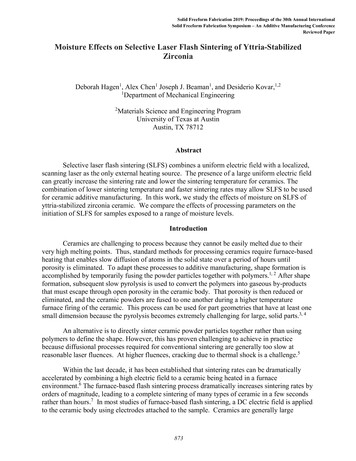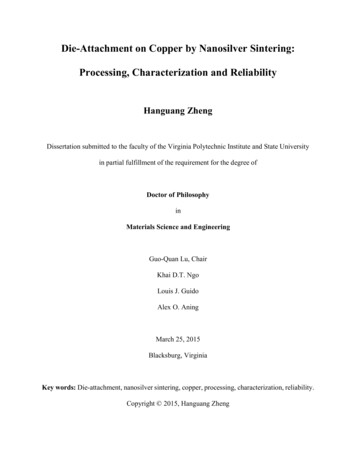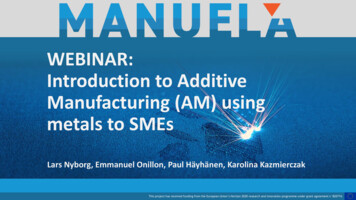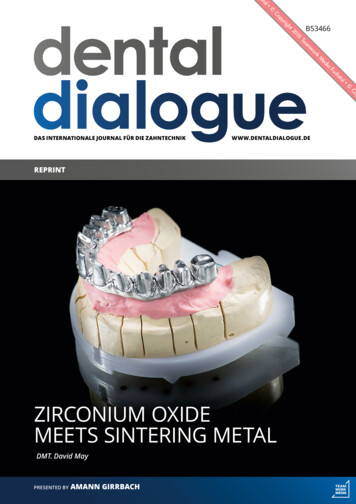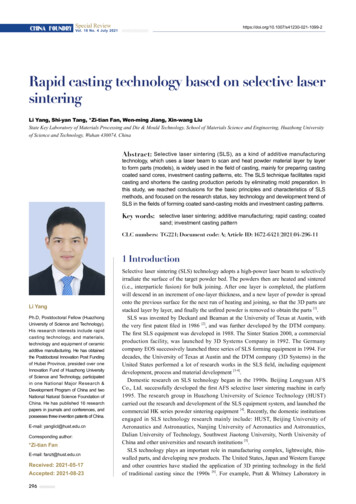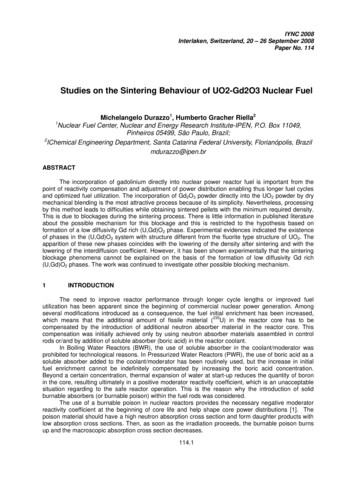
Transcription
IYNC 2008Interlaken, Switzerland, 20 – 26 September 2008Paper No. 114Studies on the Sintering Behaviour of UO2-Gd2O3 Nuclear FuelMichelangelo Durazzo1, Humberto Gracher Riella21Nuclear Fuel Center, Nuclear and Energy Research Institute-IPEN, P.O. Box 11049,Pinheiros 05499, São Paulo, Brazil;2IChemical Engineering Department, Santa Catarina Federal University, Florianópolis, Brazilmdurazzo@ipen.brABSTRACTThe incorporation of gadolinium directly into nuclear power reactor fuel is important from thepoint of reactivity compensation and adjustment of power distribution enabling thus longer fuel cyclesand optimized fuel utilization. The incorporation of Gd2O3 powder directly into the UO2 powder by drymechanical blending is the most attractive process because of its simplicity. Nevertheless, processingby this method leads to difficulties while obtaining sintered pellets with the minimum required density.This is due to blockages during the sintering process. There is little information in published literatureabout the possible mechanism for this blockage and this is restricted to the hypothesis based onformation of a low diffusivity Gd rich (U,Gd)O2 phase. Experimental evidences indicated the existenceof phases in the (U,Gd)O2 system with structure different from the fluorite type structure of UO2. Theapparition of these new phases coincides with the lowering of the density after sintering and with thelowering of the interdiffusion coefficient. However, it has been shown experimentally that the sinteringblockage phenomena cannot be explained on the basis of the formation of low diffusivity Gd rich(U,Gd)O2 phases. The work was continued to investigate other possible blocking mechanism.1INTRODUCTIONThe need to improve reactor performance through longer cycle lengths or improved fuelutilization has been apparent since the beginning of commercial nuclear power generation. Amongseveral modifications introduced as a consequence, the fuel initial enrichment has been increased,235which means that the additional amount of fissile material ( U) in the reactor core has to becompensated by the introduction of additional neutron absorber material in the reactor core. Thiscompensation was initially achieved only by using neutron absorber materials assembled in controlrods or/and by addition of soluble absorber (boric acid) in the reactor coolant.In Boiling Water Reactors (BWR), the use of soluble absorber in the coolant/moderator wasprohibited for technological reasons. In Pressurized Water Reactors (PWR), the use of boric acid as asoluble absorber added to the coolant/moderator has been routinely used, but the increase in initialfuel enrichment cannot be indefinitely compensated by increasing the boric acid concentration.Beyond a certain concentration, thermal expansion of water at start-up reduces the quantity of boronin the core, resulting ultimately in a positive moderator reactivity coefficient, which is an unacceptablesituation regarding to the safe reactor operation. This is the reason why the introduction of solidburnable absorbers (or burnable poison) within the fuel rods was considered.The use of a burnable poison in nuclear reactors provides the necessary negative moderatorreactivity coefficient at the beginning of core life and help shape core power distributions [1]. Thepoison material should have a high neutron absorption cross section and form daughter products withlow absorption cross sections. Then, as soon as the irradiation proceeds, the burnable poison burnsup and the macroscopic absorption cross section decreases.114.1
Proceedings of the International Youth Nuclear Congress 2008From a nuclear viewpoint, gadolinia is an excellent burnable poison, having a high neutronabsorption cross section coupled to a burn up rate that, if properly designed, can match approximately235theU depletion, minimizing the reactivity penalty at end-of-cycle (EOC) [2,3]. The UO2-Gd2O3poisoned fuel was first introduced in 1967 in the BWR type Dresden 2 reactor and has beenuniversally used in all commercial BWR reactors since then. The maximum Gd2O3 concentrationusually incorporated to the BWR fuel is about 4 wt%. Its use in PWR reactors is more recent and ingeneral requires higher Gd2O3 concentrations (up to 10 wt%). This type of fuel is being proposed to beimplanted in Brazil according to the future requirements established for Angra II nuclear power plant.Four different methods for the conversion of UF6 to ceramic grade UO2 powder have beendeveloped to an industrial scale [4]. Two of them, the ammonium diuranate (ADU) and ammoniumuranyl carbonate (AUC) processes, are based upon precipitation of uranium compounds fromaqueous solution. The other two follow a dry route in which UF6 is decomposed and reduced by steamand hydrogen in either fluidized beds or rotating kilns.From all these processes, the AUC process [5] is the most attractive due to the smallest numberof process steps involved. The AUC process major advantage is the good flowability of the UO2powder produced, what allow the direct pelletizing process. In the AUC process the Gd2O3 powder isincorporated to the UO2 powder by the dry mechanical blending method. Then, the mixed UO2 andGd2O3 powder is directly pressed into pellet form, without pre-pressing and granulating steps [6,7]. Inthe other industrial processes the Gd2O3 powder is added to the UO2 powder in the milling step, andthe two powders are co-milled. The mixed powder is pre-pressed and granulated [6].Nevertheless, the incorporation of Gd2O3 powder to the AUC deriving UO2 powder by the mostattractive commercial method of dry mechanical blending leads to difficulties while obtaining sinteredUO2-Gd2O3 pellets with the minimum required density [7,8], due to the deleterious effect of the Gd2O3on the traditional UO2 sintering behaviour.As the AUC technology is already implanted at INB (Brazilian Nuclear Industries), the method toproduce UO2-Gd2O3 fuel pellets would be the dry mechanical blending method. The purpose of thiswork is to investigate the possible causes for explaining the bad sintering behaviour of the UO2-Gd2O3fuel prepared by the dry mechanical blending method. Once elucidated the sintering blockagemechanism, the final objective of the investigation program is to propose possible actions to overcomethe sintering blockage, in order to obtain pellets with good sintered densities.2LITERATURE SURVEY ON SINTERING UO2-Gd2O3 FUELSeveral researchers report on the sintering UO2-Gd2O3 mixed oxides, a number of thempointing to difficulties in sintering fuel pellets with the minimal specified density, of around 94 % of thetheoretical density. Besides, a considerable disagreement between the published data can beobserved. Despite the sintering conditions are not identical, the wide variation observed in the finaldensities of the sintered fuel pellets cannot be explained only based on this reason. The influence ofthe Gd2O3 content into the fuel is evident in some sintering results, but it does not appear to besignificant in the others. Figure 1 summarizes the final densities achieved by different researchers insintering UO2-Gd2O3 pellets under reducing atmosphere. A wide range of sintered densities can beobserved in this figure. Table 1 presents the main experimental conditions adopted in the sinteringexperiments.The few sintering curves available in the literature show that the lower sintered densities aredue to an abnormal sintering behaviour of the UO2-Gd2O3 fuel, when compared with the sinteringbehaviour of the traditional UO2 fuel. The dilatometric analyses show that at temperatures aroundo1100-1400 C, the shrinkage of the UO2-Gd2O3 pellets is delayed, the sintering rate is decreased andthe densification is shifted to higher temperatures [7,17,18,20]. Yuda and Une [20] prepared the mixedpowders by co-milling. The other researchers prepared the mixed powder by the dry mechanicalblending method. The sintering atmosphere changed from very reducing to oxidizing. The sinteringcurves showed equivalent sintering behaviour in spite of the method for mixed powder preparation andsintering atmosphere. The sintering blockage was always evidenced.Otherwise, sintering curves obtained in previous work [17] showed that the sintering blockagedoes not occur when the samples are prepared by the co-precipitation method through ADU. In this114.2
Proceedings of the International Youth Nuclear Congress 2008case, very high sintered densities are achieved under the same sintering conditions adopted in thecase of dry mechanical blending samples. The co-precipitated UO2-Gd2O3 powder is prepared bymixing uranium and gadolinium nitrates and adding a dilute ammonium hydroxide solution. Theobtained material is decomposed by heating in air and reduced in a hydrogen atmosphere. Thegadolinium distribution into the mixed powder is very homogeneous. This method is mostly used inlaboratories to produce homogeneous pellets for measurement of cell constants and thermalproperties of the (U,Gd)O2 solid solutions [9,21,22].Density ][18][19]02468101214161820Gd2O3 Concentration (wt%)Figure 1: Effect of gadolinia content on sintered density of UO2-Gd2O3 fuel pellets.Table 1: Main experimental conditions for the data presented in Figure 1Ref.SinteringCycleUO2 BETSurface(m2/g)[9]1750oC/4hn.i.Ar/8%H2/H2O co-precip.[10]1650oC/4hn.i.N2/8%H2/H2O co-precip.[11]1750oC/4hn.i.25%N2/75%H2 co-milling[12]o1750 C/6h3.50H2/H2Oco-milling[13]1620oC/3h1.60pure H2co-milling[14]ao1700 C/2h4.37pure H2co-milling[14]b1700oC/2h6.65pure H2co-milling[8]1750oC/2hn.i.pure H2dry blend[15]o1700 C/2h3.10pure H2dry blend[16,17]1650oC/3h5.6pure H2dry blend[18]1680oC/4h5.0pure H2dry blend[19]on.i.N2/6%H2dry blend1650 C/4hSinteringAtmospheren.i. – not informed114.3Method forMixedPowderPreparation
Proceedings of the International Youth Nuclear Congress 2008As well as the densification results in sintering UO2-Gd2O3 pellets are discrepant andcontradictory, likewise are the mechanisms proposed to explain the sintering behavior.Une and Oguma [15] rationalize the sintering behavior of the UO2-Gd2O3 system by analogy tothe UO2-PuO2 system. According to these investigators, when sintering UO2-Gd2O3 fuel underreducing atmosphere, the system becomes hypostoichiometric to compensate electrically the3 incorporation of Gd ions in the cubic fluorite-type structure of UO2. Anion vacancies are formed tobalance the electrical charge. In this condition, as in the case of the UO2-PuO2 system, the cationdiffusivity decreases under hypostoichiometric conditions that prevail during sintering, which wouldexplain the low sintered densities achieved while sintering UO2-Gd2O3 fuel pellets. Davis and Potter[19] also attribute the low densities achieved in sintering UO2-Gd2O3 to the hypostoichiometric4 3 situation caused by the substitution of U ions by Gd ions, which would reduce the cation mobilityand, consequently, the densification during sintering.In opposition to the above explanation, Ho and Radford [12] explain their high densitiesachieved in sintering UO2-Gd2O3 fuel pellets with base in the formation of oxygen vacancies and4 oxidation of U ions. According to these investigators, the electrical charge compensation due to the3 Gd ions incorporation in the UO2 fluorite structure is accomplished by the formation of oxygen4 5 6 3 vacancies and oxidation of U ions to U and/or U ions. When Gd ions are incorporated by the4 5 6 UO2, the oxidation of U ions to U and U ions, which have smaller ionic radii, enhances the cationdiffusion and leads to high sintered densities. Above a critical level of Gd2O3 addition (around 6 wt%)3 5 6 the diffusivity is inhibited due to the association of Gd ions with U or U . In this case, theassociated cations should moves only by cooperative transport, which reduces the sinterability of thesystem. According to Ho and Radford [9], the increase in the oxygen potential reduces the oxygenvacancies concentration and also allow the creation of oxygen interstitials, which would5 6 counterbalance the formation of the small size cations (U and U ), reducing the diffusivity and,therefore, the sinterability. The association of cations also would be favored.Manzel and Dörr [7] attribute the low densities observed in sintering UO2-Gd2O3 pellets to theformation of the solid solution simultaneously with the densification process. During sintering, thediffusion processes lead not only to the densification but also to the formation of solid solutions. Theinterdiffusion processes decrease the sintering rate and shift the densification to higher temperatures.Assmann, Pehhs and Roepenack [8] complement this proposition by mentioning that the diffusioncoefficients in the UO2-Gd2O3 system depend in a complex manner on the relationship U:Gd:O relationin the generated oxide phases. Peehs, Dörr, Gradel and Maier [23] detected in sintered UO2-Gd2O3pellets the presence of a (U0.5Gd0.5)O2 phase, without, however, discuss its possible participation inthe sintering blockage mechanism. In all these studies, the samples were prepared by the drymechanical blending method, which used UO2 powder derived from AUC. Once considered that thesintering blockage occurs during the solid solution formation, that the diffusion coefficient depends onthe oxide phases formed and the observation of the (U0.5Gd0.5)O2 phase, it can inferred that the causeproposed for the sintering blockage in the UO2-Gd2O3 system is related to the formation of lowdiffusivity phases during the sintering process, which reduces the densification and leads to lowsintered densities.Yuda and Une [20] proposed that the sinterability of the UO2-Gd2O3 system could not just beevaluated from the viewpoint of cation diffusivity. According to these investigators the two peaksobserved in their sintering rate curves correspond to the reaction between adjacent UO2-UO2 particles(first peak) and to the reaction between adjacent UO2-Gd2O3 particles (second peak). They proposedthe formation of large closed pores due to the difference in the sintering rates between UO2-UO2particles and UO2-Gd2O3 particles, which generates local and nonuniform volumetric changes. As thelarge pores are formed in high temperatures, when the pore structure is already partially closed, theyare difficult to be eliminated in the posterior sintering treatment. This effect is more intense in oxidizingatmospheres because the pore structure is already essentially closed when the larges pores areformed. This explains the lower density observed in UO2-Gd2O3 pellets sintered under oxidizingatmospheres.Nishida and Yuda [11] also explain the decrease in the density of samples sintered under higheroxygen potential atmosphere on the basis of closed porosities formation. Despite the diffusivity of Uand Gd ions is enhanced corresponding with the oxygen potential, under oxidizing atmospheres the114.4
Proceedings of the International Youth Nuclear Congress 2008effective diffusion length necessary to form solid solution is slightly elongated due to a barrier effect ofclosed porosities formation, which also results in sintered density decrease.Song et al. [18] concluded that the sintered density of UO2-Gd2O3 pellets is decreased due tothe formation of new pores in the regions with high Gd concentration as the oxygen potential of thesintering atmosphere increased. The delay of densification occurs together with the solid solutionoformation in the temperature range of 1300-1500 C. While the formation of (U,Gd)O2 progresses, newpores are produced at the original sites of Gd2O3 particles as a result of the directional diffusion of Gdions into UO2. The delay of densification is mainly attributed to the formation of new pores.The sintering results in the Figure 1 and the experimental conditions presented in the Table 1indicate that the method for the UO2-Gd2O3 mixed powder preparation exerts an important influence inthe densification during the sintering process. This influence was confirmed by experimental resultspreviously published, presented in the Figure 2. The level of homogeneity of the gadoliniumdistribution in the UO2 powder determines not only the final sintered density, as well as the form of thesintering curve, as presented in Figure 3. When the homogeneity of the gadolinium distribution isgood, high densities are obtained during sintering and the sintering blockage is not apparent. On theother hand, when the homogeneity of the gadolinium distribution is bad, low densities are obtainedafter sintering and the sintering blockage is evidenced, which occurs in two stages [17]. Themechanism proposed by Une and Oguma [15] and Davis and Potter [19] to explain the sinteringbehaviour of the UO2Gd2O3 fuel is not consistent with the results presented in Figures 2 and 3. Whenthe gadolinium distribution into the fuel is good, as a solid solution (ADU co-precipitation route), highdensities are achieved and no blockage is evidenced (see Figure 3). So, the mechanism proposed byHo and Redford [12] seems to be valid when the gadolinium distribution is homogeneous enough.Density (%TD)100Co-precipited ADUCo-precipited AUCDry Mechanical Blending9998979695949392919089012345678910Gd2O3 Concentration (wt%)Figure 2: Effect of the mixed powder preparation method on the sintered density of UO2-Gd2O3 fuelpellets.On the other hand, when the gadolinium distribution into the fuel is not homogeneous (drymechanical blending route), the sintering blockage is evidenced (see Figure 3) and the diffusionbarrier formation mechanism (formation of Gd rich phases with low diffusivity) seems to be possible.Also, the mechanism based on the pore formation during sintering [11,18,20] must be consideredpossible.In this work, it is studied the mechanism based on the formation of low diffusivity Gd rich(U,Gd)O2 phases that could actuate as a diffusion barrier during the sintering process.114.5
Proceedings of the International Youth Nuclear Congress 2008Figure 3: Effect of the mixed powder preparation method on the sintering behaviour of UO2-Gd2O3 fuelpellets.3PHASES IN THE UO2-Gd2O3 SYSTEMOnce the ADU co-precipitation method for UO2-Gd2O3 powder and pellets preparationdemonstrated to result in samples with a high gadolinium homogeneity degree (solid solution) [17],this method was selected for preparation of samples containing concentrations of Gd2O3 from 0 to 100wt%. These samples made possible the accomplishment of an investigation for verifying the existenceof phases with low cation diffusivity in the (U,Gd)O2 system, which could base the diffusion barrierhypothesis.114.6
Proceedings of the International Youth Nuclear Congress 20083.1ExperimentalThe samples were prepared by co-precipitation from ADU, starting from mixed nitrate solutions.The UO2- Gd2O3 mixed powders were fabricated with Gd2O3 content in the range of 0 to 100 wt%. Thegadolinium oxide, purity 99.9 %, was supplied by Ventron Alfa Produkte. The UO2 powder wasobtained from uranium hexafluoride via AUC conversion. The aqueous solutions of uranyl nitrate andgadolinium nitrate were prepared by dissolving UO2 and Gd2O3 powder with 7N nitric acid solution.The uranyl and gadolinium nitrate solutions were thoroughly blended together in varying proportionsup to 100 wt% Gd2O3. The ADU was precipitated by adding of a 13 M NH4OH solution (4 ml/min) toothe UO2(NO3)2/Gd(NO3)3 solutions at 60 C. The final pH value was adjusted to reach pH 9. Stirringwas applied with a glass rod during the addition of the solution. The precipitates were vacuum filteredoand dried in an oven at 80 C during 24 h. The dried precipitates were reduced to uranium-gadoliniumooxide in a tubular furnace at 650 C under hydrogen atmosphere.2The mixed oxide powders were pressed into pellets in the range of 2.5 to 4.0 tf/cm in order toobtain green densities of around 50 % of the theoretical density. Before pressing, the powders weregranulated to achieve the required green density. The green pellets were sintered in a hydrogenoatmosphere at 1650 C for 3 h. The sintered densities were determined by measuring the weight ofsamples immersed in xylol (Archimedes principle).3.2Results and DiscussionThe variation of the sintered densities as function of the molar fraction of gadolinium present inthe sample demonstrates that exist ranges of gadolinium concentration for which the sintereddensities are unequivocally decreased, as can be observed in Figure 4. An increase of the sintereddensity with the increase in the Gd2O3 concentration occurs up to 10 wt%, as presented in the Figure2. This increase reaches a saturation starting from the composition (U0.9Gd0.1)O2, when a highdensification level is maintained up to the composition (U0.5Gd0.5)O2. In this gadolinium concentrationrange the sintered densities remain very high, varying in the range from 98 to 99 % of the theoreticaldensity. These high sintered densities can be explained according to the model proposed by Ho and3 Radford [12], in which the presence of Gd ions causes an increase in the cation diffusivity and,therefore, an increase in the sinterability of the UO2.Density 0,20,30,40,50,60,70,80,91,0x in (U1-xGdx)O2Figure 4: Effect of the gadolinium concentration on the sintered density of (U,Gd)O2 pellets preparedby co-precipitation (solid solution).114.7
Proceedings of the International Youth Nuclear Congress 2008When the number of Gd atoms outreaches the number of U atoms (Gd 0.5), the sintereddensities decrease drastically and reach a minimum value for the composition (U0.3Gd0.7)O2. Thefurther increase in the molar fraction of gadolinium elevates the sinterability of the (U,Gd)O2 systemagain, until reaching a maximum for the composition (U0.2Gd0.8)O2, when densities of about 93 % ofthe theoretical density are obtained. After this densification peak, a new decrease in the sinterability isobserved. Another minimum is observed in the composition (U0.18Gd0.82)O2, when the densificationlevel rises to the typical density reached in sintering pure Gd2O3 pellets (94 % of the theoreticaldensity).It is interesting to notice the behaviour of the curve presented in Figure 4 between thecompositions (U0.3Gd0.7)O2 and (U0.18Gd0.82)O2, where it can be observed a peak in the sintereddensities. This behaviour was confirmed through repetitions in sintering tests for the composition(U0.2Gd0.8)O2 and by sintering the intermediate compositions between Gd 0.7 and Gd 0.9.The UO2-Gd2O3 sintered pellets were milled and analyzed by x-ray diffraction. The latticeparameters of (U,Gd)O2 were determined with base on the diffractograms. Figure 5 presents thevariation of the lattice parameter in function of the molar fraction of gadolinium in the sample. A lineardecrease on the lattice parameter occurs for compositions up to (U0.5Gd0.5)O2, according Vegard’s law.3 This observation indicates the presence of a single phase with fluorite type structure, with Gd ions4 substituting U (solid solution). A good adjustment was obtained in a linear regression from theexperimental data. The straight line can be expressed by the equation:a 0.54636 – 0.01592 . x(1)where: a is the lattice parameter (nm) and x is the molar fraction of gadolinium.Lattice Parameter (nm)0,5470,5464 (pure UO2 )0,546FCC(solid solution)0,545undetermined multi-phase system BCC possible 3 rhombohedral phases mono0,5440,5430,5420,5410,5404(pure GdO1,5 0,60,70,80,91,0x in (U1-xGdx)O2Figure 5: Variation of the lattice parameter with dissolved gadolinium content.When the molar fraction of gadolinium outreaches the value 0.5, the behaviour of the latticeparameter of the fluorite structure is not linear anymore, which indicates the end of the single-phasefield. For compositions between (U0.25Gd0.75)O2 and (U0.10Gd0.90)O2, the diffractograms indicate onlythe presence of the body centered cubic structure, when a tendency to linear decrease on the latticeparameter with the molar fraction of gadolinium can also be observed. However, in this case, it is notpossible to affirm that the Vegard’s law is obeyed, once a bad adjustment was obtained in a linearregression from the experimental data. This observation may indicate the existence of two or more114.8
Proceedings of the International Youth Nuclear Congress 2008phases in that composition range. An attempt to fit a straight line to the data is illustrated in Figure 5.The straight line can be expressed by the equation:a 0.54809 – 0.00773 . x(2)In the intermediate range of composition between (U0.5Gd0.5)O2 and (U0.25Gd0.75)O2 it cannot beaffirmed that occur the simple coexistence between the FCC and BCC phases, once the latticeparameter is not constant for none of the two structures. For compositions between (U0.25Gd0.75)O2and (U0.1Gd0.9)O2 it also cannot be affirmed that the system is single-phase with BCC structure, oncecannot be affirmed that the Vegard’s law is obeyed. Therefore, in that extensive composition range,where the molar fraction of gadolinium varies from 0.5 to 0.9, the results presented in Figure 5 indicatethe existence of one or more phases different from the FCC fluorite structure of UO2 and BCC ofGd2O3. For compositions over (U0.10Gd0.90)O2 the coexistence between the forms C and B of Gd2O3was evidenced, with structures BCC and monoclinic, respectively.Aitken, Bartran and Juenke [24] observed a phase with rhombohedral structure in the U-Y-Osystem, with composition varying in a wide range of yttrium concentration, from 51 to 86 mol%. Thisphase was designated RI. A second phase was observed in this system, also with rhombohedralstructure, designated RII, with composition varying between 68 and 75 mol% yttrium. These tworhombohedral phases were also observed in the U-La-O system and a third rhombohedral phase,designated RIII, was detected in the concentration range varying from 55 to 67 mol% of lanthanum[25].These rhombohedral phases were also observed in the compounds U-R-O (R Nd, Sm, Eu, Ho,Er, Tm, Yb and Lu) and in the rare earth R-O system, where R Ce, Pr and Tb, which can presentvalences 3 and 4. Kang and Eyring [26] observed that these rare earths exhibit a family of binaryoxides where coexist the valences 3 and 4, resulting in oxygen deficient fluorite related structures.Among them, the composition R7O12 has the same rhombohedral structure observed in the U-Y-Osystem. In that and in subsequent reports [27], these researchers propose the construction ofcrystalline structures of a group of compounds in the R-O system by assembling modules, which areunitary cells of the fluorite structure with oxygen vacancies in different positions in the unitary cell. Withbase in that mechanism, these researchers established and characterized 14 different phases in theR-O system. The R7O12 phase is isostructural to the rhombohedral UGd6O12 phase.The experimental observation of the phases built with base in the methodology proposed byKang and Eyring indicates that an extensive series of phases with structure based on the fluoritestructure may exist, where oxygen vacancies are distributed in different ways. This is an importantconclusion; once phases that are isostructural to the phases observed by Kang and Eyring in the R-O4 system may probably also exist in the system U-Gd-O. The U cation can be present in these4 5 structures substituting the R cation. Besides, with the possibility for occurrence also of the U and6 U cations, the possibility for occurrence of phases more complex than the identified ones cannot bediscarded.Many researchers agree that the stoichiometry in the (U,Gd)O2 system stays close to 2 up tothe concentration of 40 mol% Gd2O3 [9,28,29,30]. It is also noticed the occurrence of a slighthypostoichiometry in this system for this Gd2O3 concentration range. Starting from 40 mol% Gd2O3,Beals and Handwerk [28] observed a consistent decrease in the O/M ratio with the increase in themolar fraction of gadolinium, until the value of 1.5 is reached in the case of pure Gd2O3. With base in3 4 the literature, it can be considered that when Gd cations are incorporate in the fluorite structure, Ucations may be oxidized for load compensation. According to Ohmich et al [30], the formation of asmall proportion of oxygen vacancies may also occurs, probably randomly distributed in the crystallattice of the solid solution, which is evidenced by the hypostoichiometry. This mechanism, whichwould be the model 3 proposed by Ho and Radford [12], could be considered valid for Gd2O3concentrations up to 50 mol%.Above 50 mol% in Gd2O3, it is started a systematic formation of oxygen vacancies for loadcompensation. When the number of oxygen vacancies reaches a critical value, the oxygen vacanciesrearranges to form new phases that would be isostructural to the ones observed and modelled byKang and Eyring in the R-O system, as discussed previously. The rhombohedral phase would114.9
Proceedings of the International Youth Nuclear Congress 2008probably be one of them. In that way, the variation on the lattice parameter as function of the molarfraction of gadolinium stops satisfying the Vegard’s law. With the continuous increase in the number ofoxygen vacancies, the crystalline structure develops until obtaining the BCC structure of Gd2O3, where16 oxygen vacancies are present. If the straight line that represents the variation of the latticeparameter in the composition range of x 0.75 to 0.9 is extrapolated, it intercepts the ordinate axis atthe value 0.5404 nm for x 1 (GdO1.5), which is very close to the x-ray diffraction standard value of1.0813 nm for the Gd2O3 unitary cell, or 0.5407 nm for the pseudo fluorite cell of the GdO1.5.The beginning in the sinterability decrease in the UO2-Gd2O3 system corresponds to the end ofthe monophase area in the system, with fluorite structure, for the composition
2 LITERATURE SURVEY ON SINTERING UO2-Gd2O3 FUEL Several researchers report on the sintering UO 2-Gd 2O 3 mixed oxides, a number of them pointing to difficulties in sintering fuel pellets with the minimal specified density, of around 94 % of the theoretical density. Besides, a considerable disagreement between the published ata can be d observed.


